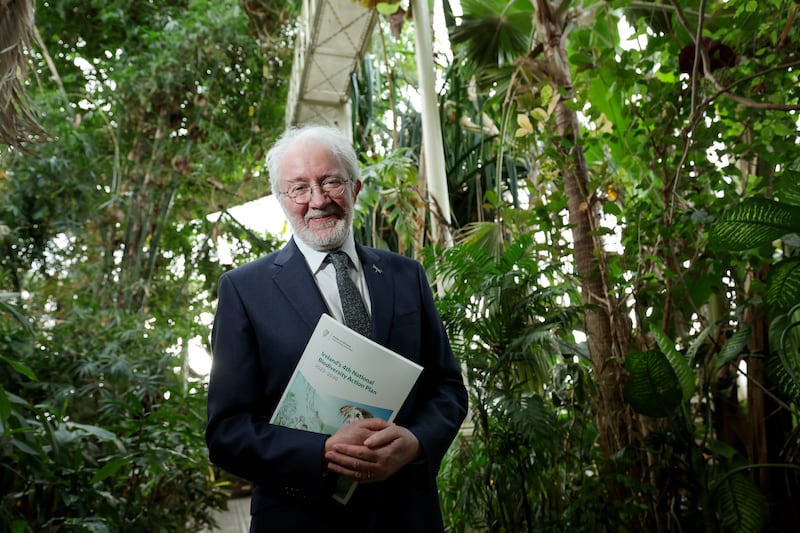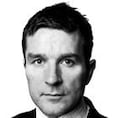Scoil Iognáid in Galway is down at the end of a narrow street called Raleigh Row. The Gaelscoil is the first in the city with a traffic free, safe street for pupils going to school. The impact has been transformative.
Green Party leader Eamon Ryan is on hand for the official opening of the kind of project championed by his party. Príomhoide Laoise Bhreathnach shows before and after photographs that juxtapose traffic chaos and traffic-free calm.
Ryan, the Minister for Transport, talks about his ambition for this to happen at all schools. “You need to go for moonshots in your politics and life,” he tells the audience.
Firing off moonshots, sometimes in the face of stark reality, is what Ryan’s political career has been all about. For example, the Green Party is running a record 129 candidates in the local elections.
READ MORE
If history is telling the Greens anything, it is that the smallest party in a coalition takes a pasting, irrespective of how well the government performs. After going into coalition with Fianna Fáil in 2007, the party went on to lose 15 of its 18 council seats in 2009 and was wiped out completely in the 2011 general election.
Outside Dublin – particularly in rural Ireland – the party has been portrayed as a pantomime villain by its opponents – against roads; responsible for carbon tax and for fuel hikes; against turf-cutting; and even against rural Ireland
It has made a comeback since, with 49 councillors and two MEPs elected in 2019 and 12 TDs in 2020. Now back in Government, its opponents are predicting big Green losses. But Ryan is talking up their chances of gaining seats in the local elections.
The party insists that this time is different. It’s bigger and more savvy, and climate change is on more peoples’ radars. It has more sway in Government and much more money to do green things with budgets running into billions for sustainable and active travel, public transport, agriculture, clean energy, the circular economy, the arts and heritage.
And yet, and yet. Outside Dublin – particularly in rural Ireland – the party has been portrayed as a pantomime villain by its opponents – against roads; responsible for carbon tax and for fuel hikes; against turf-cutting; and even against rural Ireland.
On canvass with the Greens in two of its stronger areas outside Dublin – Galway and Kilkenny – there is a clear sense the party will have its work cut out.
Ryan joins European election candidate Pauline O’Reilly and city councillor Niall Murphy on the hustings in Glenard, a middle class area in Salthill.
Murphy is a flame-haired man with an easy-going temperament. He has fought almost a lone battle on Galway City Council to get more cycle paths in the most traffic-clogged and bicycle-averse city in Ireland.
In Dalton Drive, there is a conversation about cycling infrastructure. Ryan, whose department is responsible, tells the woman that because of the slow pace of implementation, “Galway has a real risk of falling behind other cities” in getting funding for sustainable and active travel.
An exchange ensues, the pattern of which will be repeated – more or less – half a dozen times along this street.
“Traffic in Galway is dire,” says the woman.
“The only solution is more public transport,” says Ryan.
“Public transport is dire,” says the woman. “We lived in Dublin for years and were shocked to see how bad it is.”
O’Reilly explains that the problem partly stems from dealing with a conservative council and executive.
[ Galway ring road plan quashed as board admits it was not aware of climate planOpens in new window ]
The woman concludes, however, by pronouncing the need for the outer ring road. Ah, the ring road – aka the electoral albatross around the Greens’ neck. The party has opposed previous plans for it, a move which has not made it a friend of motorists. Ryan tells the woman better public transport and more cycle lanes would be the best way to take traffic off the roads as people would have an alternative.
She looks unconvinced. As do others.
Cllr Murphy chats to a man named Aidan who is standing in his driveway. He points across to Ryan and says: “Your man across the road has succeeded in stopping the ring road. Ye shafted it.”
Further along Ryan meets Peter Murphy, who runs an electrical retail business. The Greens objected to the ring road, Murphy says, and he can no longer vote for the party. Ryan argues that allocating road space to cycling, walking and buses will take cars off the road.
[ The Irish Times/Ipsos B&A poll: the full results in chartsOpens in new window ]
Peter Murphy responds by saying that the river divides Galway in two and a new bridge is needed nonetheless, given the population increase since the last bridge was built in the 1980s.
A few others raise the ring road. Once that’s raised, you can chalk the person down as a doubtful. There are one or two householders who say cycle lanes are needed. But it’s not 50-50.
[ Galway ring road decision should signal end of car-first planningOpens in new window ]
“We knew from history as a smaller party in Government that this election would be tougher on the doors,” says Niall Murphy. “If you are an independent or in opposition, you will have it cushy as you have no responsibility. Traffic has been bad in Galway for decades. The idea of it being the Greens’ fault is ridiculous.”
O’Reilly, standing in Midlands-North-West, is upbeat. She believes things are positive on the doors but many of her pledges are numbers twos.
[ Tide has turned for Government as Sinn Féin's large lead has now evaporatedOpens in new window ]
“It’s hard to gauge at this stage. We need to push people to give number ones. It’s more critical than ever for Greens to be elected in Europe,” she says.
Malcolm Noonan won a Dáil seat in Kilkenny in 2020 and now serves as Minister of State for Heritage. He oversaw a big expansion of the National Parks and Wildlife Service, an ambitious Biodiversity Action Plan and secured an enormous new national park in the Dingle peninsula in Kerry.
She recounts an earlier canvass where she was chased down the street by a man standing some 6ft 4in in height, who she said continuously roared the ‘c’ word and complained about migrants
But does that butter any parsnips?
We go to in Larchfield or the Village, where Noonan grew up, a neighbourhood abutted to the clubhouse of James Stephens, the famous GAA club of former Kilkenny player and manager Brian Cody. Noonan is canvassing with Cllr Maria Dollard, a disability advocate and community activist. She recounts an earlier canvass where she was chased down the street by a man standing some 6ft 4in in height, who she said continuously roared the “c” word and complained about migrants.

Today’s walkabout passes without any drama. The issues are speeding cars, traffic, opportunistic parking, flooding and the 16-year wait for, you’ve guessed it, a ring road for the city.
Noonan says the man who Dollard says chased her was not representative. “Migration is featuring on the doorsteps but not as much as some people think,” he says. “All that most people are looking for is a fair system.”
His own sense is that many have suspended their final judgment on who they will vote for.
“It’s hard to say. People are non-committal,” he adds, perhaps conceding it will be a battle for the Greens.
Asked if the party can hold, or indeed gain, seats in the forthcoming elections, he gives a candid assessment: “We are consistently a party that wants to be in government. It’s the only way we can implement the fundamental changes that we need in this country.
“And if we take a drubbing for that, then we take it, and we all come back again. I think we’re needed in our politics. And I think we’ve proven that over the last four years.”
- Sign up for push alerts and have the best news, analysis and comment delivered directly to your phone
- Find The Irish Times on WhatsApp and stay up to date
- Our In The News podcast is now published daily – Find the latest episode here

















